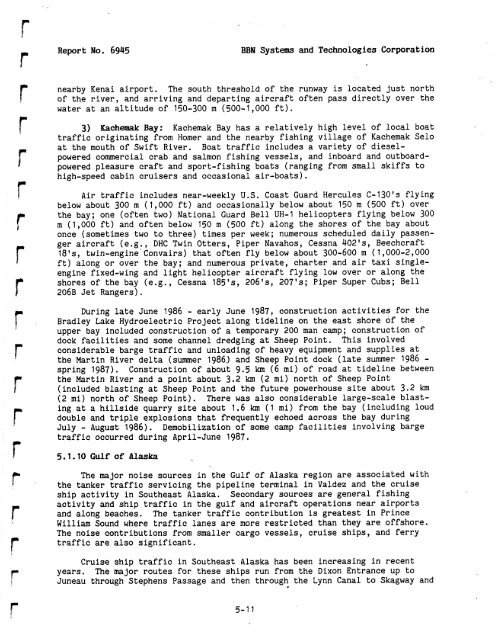Analysis and Ranking of the Acoustic Disturbance Potential of ...
Analysis and Ranking of the Acoustic Disturbance Potential of ...
Analysis and Ranking of the Acoustic Disturbance Potential of ...
You also want an ePaper? Increase the reach of your titles
YUMPU automatically turns print PDFs into web optimized ePapers that Google loves.
Report No. 6945<br />
BBN Systems <strong>and</strong> Technologies Corporation<br />
nearby Kenai airport. The south threshold <strong>of</strong> <strong>the</strong> runway is located just north<br />
<strong>of</strong> <strong>the</strong> river, <strong>and</strong> arriving <strong>and</strong> departing aircraft <strong>of</strong>ten pass directly over <strong>the</strong><br />
water at an altitude <strong>of</strong> 150-300 m (500-1,000 ft).<br />
3) Kachemak Bay: Kachemak Bay has a relatively high level <strong>of</strong> local boat<br />
traffic originating from Homer <strong>and</strong> <strong>the</strong> nearby fishing village <strong>of</strong> Kachemak Selo<br />
at <strong>the</strong> mouth <strong>of</strong> Swift River. Boat traffic includes a variety <strong>of</strong> dieselpowered<br />
commercial crab <strong>and</strong> salmon fishing vessels, <strong>and</strong> inboard <strong>and</strong> outboardpowered<br />
pleasure craft <strong>and</strong> sport-fishing boats (ranging from small skiffs to<br />
high-speed cabin cruisers <strong>and</strong> occasional air-boats).<br />
Air traffic includes near-weekly U.S. Coast Guard Hercules C-130's flying<br />
below about 300 m (1,000 ft) <strong>and</strong> occasionally below about 150 m (500 ft) over<br />
<strong>the</strong> bay; one (<strong>of</strong>ten two) National Guard Bell UH-1 helicopters flying below 300<br />
m (1,000 ft) <strong>and</strong> <strong>of</strong>ten below 150 m (500 ft) along <strong>the</strong> shores <strong>of</strong> <strong>the</strong> bay about<br />
once (sometimes two to three) times per week; numerous scheduled daily passenger<br />
aircraft (e.gl, DHC Twin Otters, Piper Navahos, Cessna 402's, Beechcraft<br />
18's, twin-engine Convairs) that <strong>of</strong>ten fly below about 300-600 m ( 1,000-2,000<br />
ft) along or over <strong>the</strong> bay; <strong>and</strong> numerous private, charter <strong>and</strong> air taxi singleengine<br />
fixed-wing <strong>and</strong> light helicopter aircraft flying low over or along <strong>the</strong><br />
shores <strong>of</strong> <strong>the</strong> bay (e.g., Cessna 185's, 206's, 207's; Piper Super Cubs; Bell<br />
206B Jet Rangers).<br />
During late June 1986 - early June 1987, construction activities for <strong>the</strong><br />
Bradley Lake Hydroelectric Project along tideline on <strong>the</strong> east shore <strong>of</strong> <strong>the</strong><br />
upper bay included construction <strong>of</strong> a temporary 200 man camp; construction <strong>of</strong><br />
dock facilities <strong>and</strong> some channel dredging at Sheep Point. This involved<br />
considerable barge traffic <strong>and</strong> unloading <strong>of</strong> heavy equipment <strong>and</strong> supplies at<br />
<strong>the</strong> Martin River delta (summer 1986.) <strong>and</strong> Sheep Point dock (late summer 1986 -<br />
spring 1987). Construction <strong>of</strong> about 9.5 km (6 mi) <strong>of</strong> road at tideline between<br />
<strong>the</strong> Martin River <strong>and</strong> a point about 3.2 km (2 mi) north <strong>of</strong> Sheep Point<br />
( included blasting at Sheep Point <strong>and</strong> <strong>the</strong> future powerhouse site about 3.2 km<br />
(2 mi) north <strong>of</strong> Sheep Point). There was also considerable large-scale blasting<br />
at a hillside quarry site about 1.6 km (1 mi) from <strong>the</strong> bay (including loud<br />
double <strong>and</strong> triple explosions that frequently echoed across <strong>the</strong> bay during<br />
July - August 1986). Demobilization <strong>of</strong> some camp facilities involving barge<br />
traffic occurred during April-June 1987.<br />
5.1.10 Gulf <strong>of</strong> Alaska -<br />
The major noise sources in <strong>the</strong> Gulf <strong>of</strong> Alaska region are associated with<br />
<strong>the</strong> tanker traffic servicing <strong>the</strong> pipeline terminal in Valdez <strong>and</strong> <strong>the</strong> cruise<br />
ship activity in Sou<strong>the</strong>ast Alaska. Secondary sources are general fishing<br />
activity <strong>and</strong> ship traffic in <strong>the</strong> gulf <strong>and</strong> aircraft operations near airports<br />
<strong>and</strong> along beaches. The tanker traffic contribution is greatest in Prince<br />
William Sound where traffic lanes are more restricted than <strong>the</strong>y are <strong>of</strong>fshore.<br />
The noise contributions from smaller cargo vessels, cruise ships, <strong>and</strong> ferry<br />
traffic are also significant.<br />
Cruise ship traffic in Sou<strong>the</strong>ast Alaska has been increasing in recent<br />
years. The major routes for <strong>the</strong>se ships run from <strong>the</strong> Dixon Entrance up to<br />
Juneau through Stephens Passage <strong>and</strong> <strong>the</strong>n through <strong>the</strong> Lynn Canal to Skagway <strong>and</strong>
















